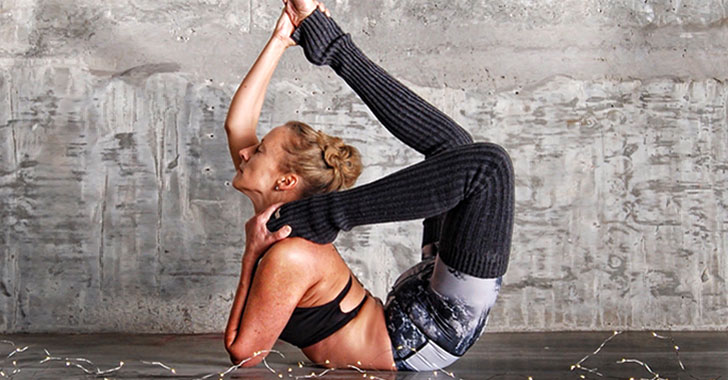Sing it with us… it’s the most wonderful (and stressful) time of the year! Oh, are those not the lyrics? Could’ve fooled us. Luckily, Instagram yoga star @RobinMartinYoga is back for another series. This time, she’ll help us get through this crazy holiday season with three hip, shoulder and heart openers (where we tend to store most of our stress).
Keep in mind, she’s literally a yoga genius, so don’t be intimidated—her how-tos include variations for both beginners and advanced yogis. Don’t forget to bookmark this post for whenever need to de-stress.
BOW POSE
First up is the bow pose. This asana relieves tension by stretching the front body and hip flexors and offers a big shoulder opener. Before jumping in, warm up with some less intense shoulder and heart openers.
- Begin lying on your belly, arms at your sides, palms face up. Tilt your pelvis forward slightly, feel your belly rise up off of the mat. This will help to lengthen your tailbone.
- Bend your knees and bring your heels as close to your seat as possible. Reach back and grab the ankles (a strap or towel can be very helpful at this stage) from the outside. Squeeze your knees toward the midline without letting them spread wider than hip-width.
- On an inhale breath, begin to press your ankles into your hands. Your thighs will rise up off of the ground, as well as your head and chest. Soften the muscles in your back and glutes. Roll your shoulders back and down, pressing shoulder blades firmly against the back ribs. Gaze is neutral.
- Stay forward, balancing on the soft part of the belly. Send your breath to the back of the torso.
*Advanced Variation // Rock your weight back onto the thighs, opening even bigger through the front body. Or flip your grip, play with leg variations, whatever serves you and your body.
CAMEL POSE
The camel pose improves respiration and balances the chakras, making it a perfect stress reliever. Plus, it strengthens back muscles, improves posture and stimulates the organs in the abdomen and neck. (Note: If you have knee issues, add padding underneath the knees).
- Kneel with knees hip distance apart and slightly rotate thighs inward (toes should not be tucked). Press your shins and tops of the feet firmly onto the mat. Place the heels of the hands on your buttocks with fingers pointing down.
- Use your hands to guide your tail slightly forward (think about a long spine all the way to the tailbone). Take an inhale breath as you slide your shoulder blades against your back ribs, feeling the opening in the front body.
- Draw the upper body up and back, keeping your hands where they are and tucking chin to sternum. This may be your stopping point.
*Advanced Variation // Keep thighs forward, hips stacked above the knees (firm buttocks, but don’t clench). Reach over and back with arms together and grab your heels. If this is too difficult, lean thighs back slightly, rotate a small amount to one side, find your heel with your hand, then switch sides. Spine is long, chest is open, hips are above the knees. Voila!
DANCER’S POSE
This beautiful heart opener is like the swiss army knife of yoga poses—it stretches hip flexors, hamstrings, strengthens the arch of the foot, opens shoulders, expands the chest and front body, and strengthens the back body. It’s also great for concentration and balance.
- Stand upright with arms at your sides in mountain pose. Shift your weight onto one foot and bend the opposite foot at the knee, bringing your heel up toward your seat. Engage the standing leg by feeling all four corners of your foot press into the floor. Engage the quadriceps and draw the kneecap up.
- Reach behind your and grab the inside edge of the foot arch or ankle with the hand on the same side of your body as the bent leg.
- Lengthen your tailbone down and engage your core. Begin to push your foot into your hand so it rises up behind and away from you. Keep your knee hugging in toward your midline and not out to the side. As your foot rises up, tilt your torso forward, maintaining a lift through your chest.
- Extend your opposite arm forward or up, perhaps finding a mudra (hand gesture) that suits you. Remember to breathe!




